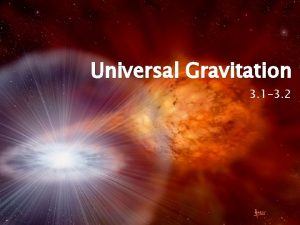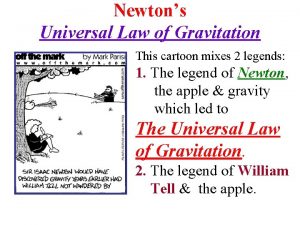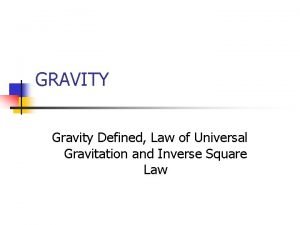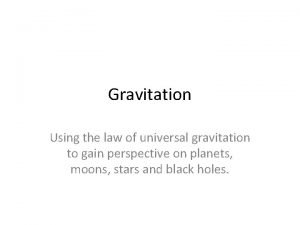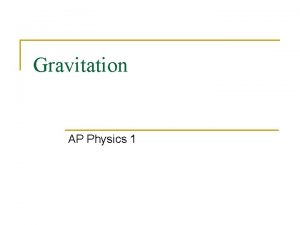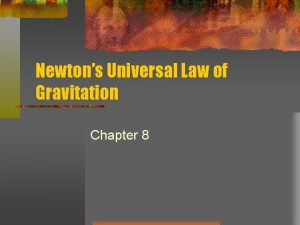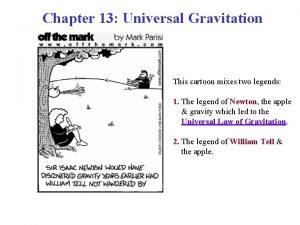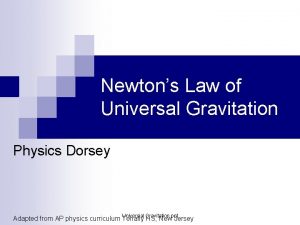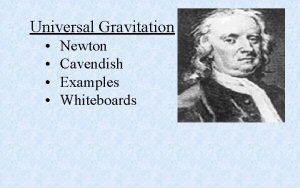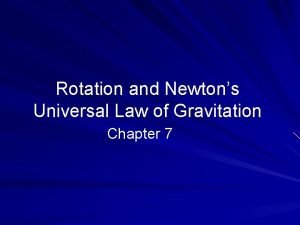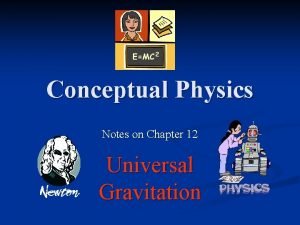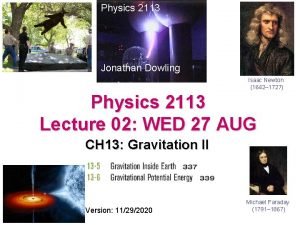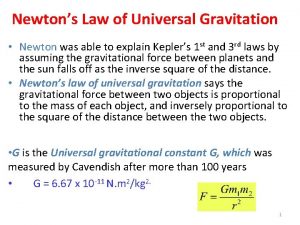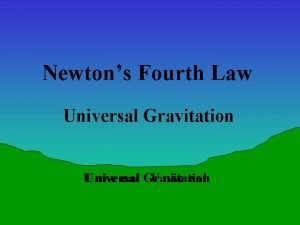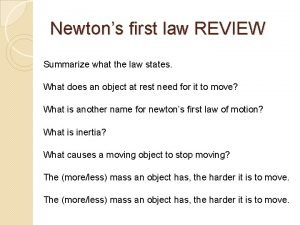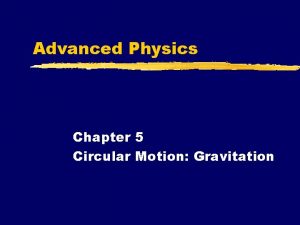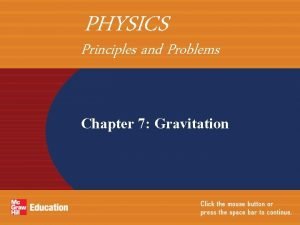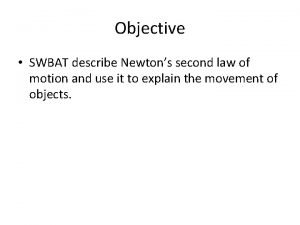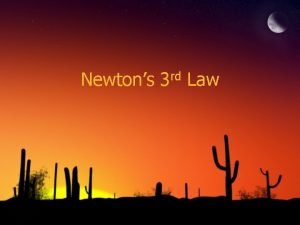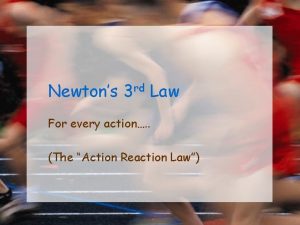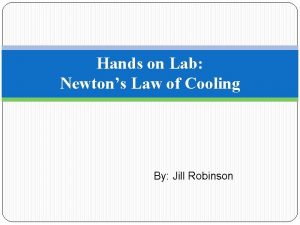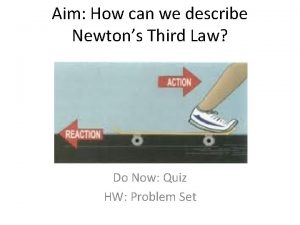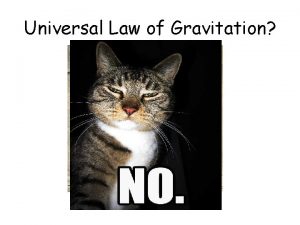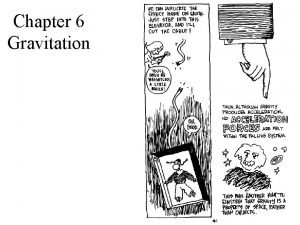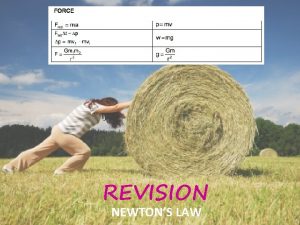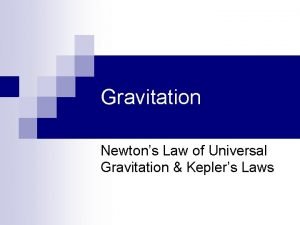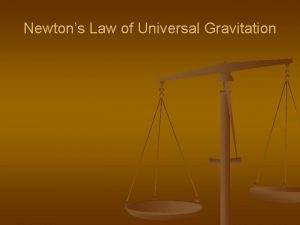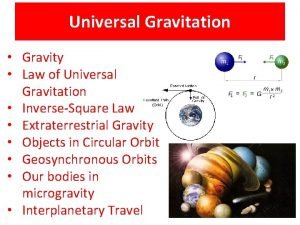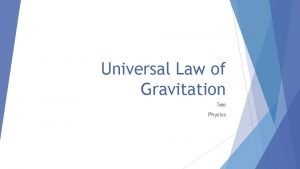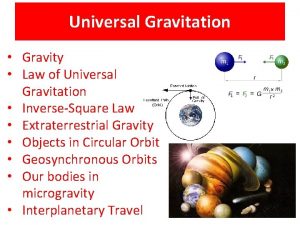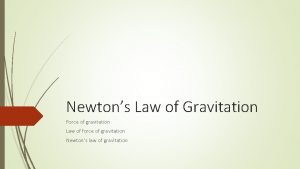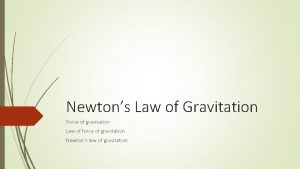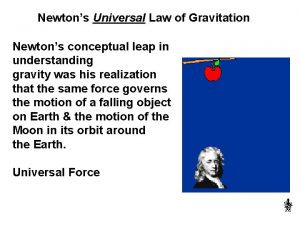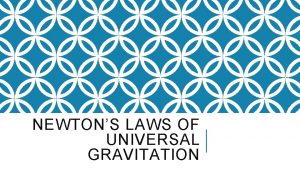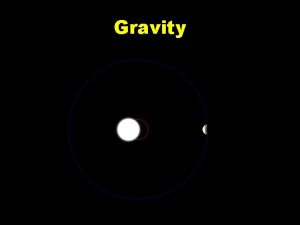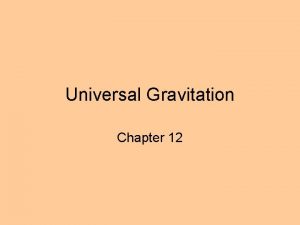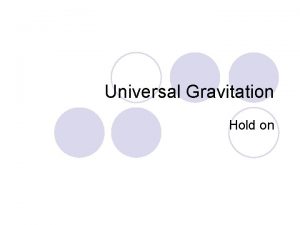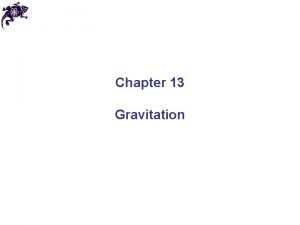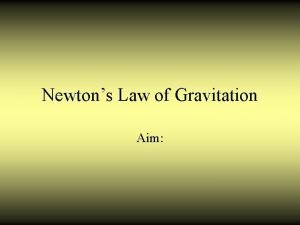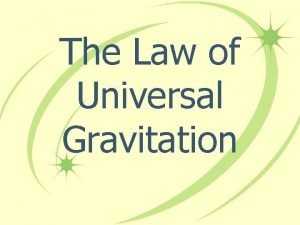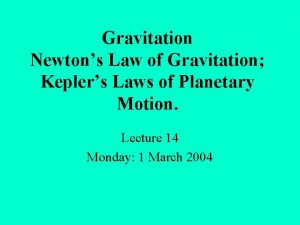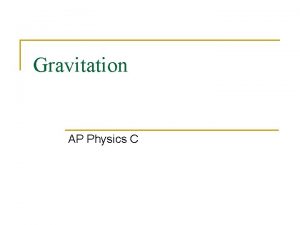Rotation and Newtons Universal Law of Gravitation Chapter



































- Slides: 35

Rotation and Newton’s Universal Law of Gravitation Chapter 7

Our friend Jupiter rotates once every 10 hours Of course Earth only rotates once every 24 hours How would we calculate the speed of a rotating object?

Objects in circular motion have a tangential speed What is tangential speed? – Tangential speed is the instantaneous linear speed of any point rotating about an axis – r is radius of circle – T is period (length of time for one rotation)

So…how do we use that? Let’s find the tangential speed of a point along Jupiter’s equator. What information do we need? – Jupiter’s Radius at the equator: 7. 15 x 107 m – The time for one rotation: 10 hours= 36000 s

Jupiter’s Speed at the Poles Jupiter is not a solid sphere, so the radius at the equator is not the same as the radius at the poles. – Jupiter’s Radius at the Poles: 6. 69 x 107 m – Time of rotation: 10 hours = 36000 s That’s a difference of 1, 792 mph!

Compare that to Earth’s equatorial radius: 6. 378 x 106 m Earth’s rotational period: 24 hrs = 86, 400 s Earth’s radius at the poles: 6. 356 x 106 m Earth’s rotational period: 24 hrs= 86, 400 s

Does an object undergoing circular motion always have the same tangential velocity? NO! Direction of velocity: Right A Direction of velocity: Up B D C Direction of velocity: Left Direction of velocity: Down

To clarify things… Points that are the same distance from the center (i. e. that have the same radius) have the same tangential speed but not the same tangential velocity!

If velocity is changing then… A change in velocity = ACCELERATION Therefore, objects that are undergoing circular motion must be accelerating!

Sample Problem p. 258 #2 A young boy swings a yo-yo horizontally above his head so that the yo-yo has a centripetal acceleration of 250 m/s 2. If the yo-yo’s string is 0. 50 m long, what is the yo-yo’s tangential velocity?

What do we have? ac= 250 m/s 2 r = 0. 5 m Rearrange the equation and solve:

Follow up question How long does it take for the yo-yo to complete one revolution? – In other words, what is the period? Rearrange the tangential speed equation to solve for T

Another follow up question! • How many rotations per second does the yo-yo make? • In other words, what is the frequency?

What causes an acceleration? A NET FORCE applied to an object causes it to accelerate Consequently, since an object that undergoes circular motion is accelerating, there must be a force that causes it to do so

Centripetal Force Remember Newton’s Second Law says F=ma Therefore

Centripetal Force is the force that maintains circular motion IT IS ALWAYS POINTED TOWARD THE CENTER OF THE CIRCLE

Sample Problem p. 261 #2 A bicyclist is riding at a tangential speed of 13. 2 m/s around a circular track with a radius of 40. 0 m. If the magnitude of the force that maintains the bike’s circular motion is 377 N, what is the combined mass of the bicycle and rider?

What do we know? Vt= 13. 2 m/s r = 40 m Fc= 377 N m=? Rearrange the equation to solve for m.

Gravity! We all know that the gravitational force is the mutual force of attraction between particles of matter Credit & Copyright: Robert Gendler

Newton’s Law of Universal Gravitation Every object in the Universe exerts a gravitational force on every other object in the universe If that’s true, why aren’t things always flying together?

Gravitational Lensing http: //occamsmachete. com/bling/gravitational-lensing. jpg

Newton’s Law of Universal Gravitation Fg is the gravitational force G is a constant m 1 and m 2 are the masses of the objects r is the distance between the objects

Newton’s Law of Universal Gravitation The law of universal gravitation is an inverse-square law – The force between two masses decreases as the distance between them increases The gravitational force between two objects is proportional to the product of the objects’ masses

Sample Problem (not in book) The average distance between the Sun and the Earth is 1. 5 x 1011 m (93 million miles). The average distance between the Sun and Pluto is 5. 9 x 1012 m (3. 66 x 109 miles). The mass of the Sun is 1. 99 x 1030 kg, the mass of the Earth is 5. 98 x 1024 kg and the mass of Pluto is 1. 31 x 1022 kg. Find the gravitational force between the Sun and the Earth, the gravitational force between the Sun and Pluto and the gravitational force between the Earth and Pluto.

Force between the Sun and the Earth

Force between the Sun and Pluto

Force between Pluto and Earth

Calculating g We’ve been using the value for acceleration due to gravity all year without knowing where it comes from. Now is the time to find out!

Calculating g Let’s say we want to know the gravitational force between the Earth and a person standing on the surface of the Earth.

What do we know Mass of the person = mp Mass of the Earth= ME RE= radius of Earth – Note that for problems like this we pretend like all the mass of the Earth is at its center. Therefore the distance between the two objects is equal to the radius of the Earth.

Relationship between weight and Fg We know that an object’s weight is equal to the gravitational force acting on it from the Earth Therefore Fg=mpg

Calculating g Using Newton’s law of gravitation Fg = mg becomes: So the expression for g is

Plug in numbers

It works for all spherical bodies

Calculate the acceleration due to gravity on Pluto
 Explain newton’s universal law of attraction/gravitation.
Explain newton’s universal law of attraction/gravitation. Cartoon law of universal gravitation
Cartoon law of universal gravitation Newton's law of universal gravitation
Newton's law of universal gravitation Gravity
Gravity Minimum speed for vertical circular motion
Minimum speed for vertical circular motion Universal gravitation law
Universal gravitation law Universal law of gravitation calculator
Universal law of gravitation calculator Newton's universal law of gravitation ap physics 1
Newton's universal law of gravitation ap physics 1 Newton's universal law of gravitation simplified
Newton's universal law of gravitation simplified Chapter 13 universal gravitation
Chapter 13 universal gravitation Law of universal gravitation ppt
Law of universal gravitation ppt Law of universal gravitation kid definition
Law of universal gravitation kid definition State newton's law of gravitation
State newton's law of gravitation Conceptual physics chapter 13 universal gravitation
Conceptual physics chapter 13 universal gravitation Gauss theorem
Gauss theorem Newton's law of gravitation
Newton's law of gravitation Newton's fourth law
Newton's fourth law How to calculate specific rotation of a mixture
How to calculate specific rotation of a mixture Mustafa sheikh lawyer review
Mustafa sheikh lawyer review Chapter 5 circular motion gravitation
Chapter 5 circular motion gravitation Chapter 7 study guide gravitation
Chapter 7 study guide gravitation Newton's first law and second law and third law
Newton's first law and second law and third law Newton's first law and second law and third law
Newton's first law and second law and third law Newtons 3 rd law of motion
Newtons 3 rd law of motion Newton's laws in soccer
Newton's laws in soccer Describe newtons second law
Describe newtons second law 1law of motion
1law of motion Newtons 3 rd law of motion
Newtons 3 rd law of motion What are newtons 3 laws
What are newtons 3 laws Newton's 3 law
Newton's 3 law Newtons 3 rd law
Newtons 3 rd law Site:slidetodoc.com
Site:slidetodoc.com Describe newtons third law
Describe newtons third law Law of thermodynamics in chemistry
Law of thermodynamics in chemistry Newtons 1law
Newtons 1law Chapter 8 ask newton
Chapter 8 ask newton
